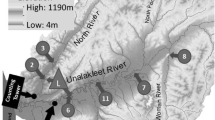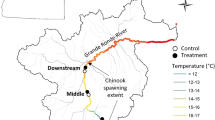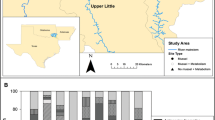Abstract
Pacific salmon (Oncorhynchus spp.) perform important ecological roles in stream ecosystems by provisioning nutrients as resource subsidies and modifying their physical habitat as ecosystem engineers. These contrasting roles result in concurrent nutrient enrichment and benthic disturbance, where local environmental characteristics potentially determine which effect predominates. Whole-stream metabolism quantifies the functional response to salmon and may identify patterns in enrichment and disturbance not apparent from structural measurements alone. We measured ecosystem respiration (ER) and gross primary production (GPP), along with chemical and physical characteristics, in seven Southeast Alaska streams and two Michigan streams, before and during the salmon run. These streams in the native and introduced ranges of salmon differed in environmental characteristics, from geomorphology at the reach scale to climate at the biome scale. Salmon consistently increased ER across streams and biomes, from an average (±SE) of 1.92 ± 0.23 g O2 m−2 d−1 before salmon to 6.30 ± 1.08 g O2 m−2 d−1 during the run. In the cobble-bottom streams of Southeast Alaska, GPP doubled from 0.29 ± 0.05 g O2 m−2 d−1 before salmon to 0.66 ± 0.16 g O2 m−2 d−1 during the run. In contrast, GPP responded inconsistently to salmon in the sand-bottom Michigan streams, increasing in one and decreasing in the other. Patterns in ER and GPP among streams and time periods were predicted by stream water nutrients (for example, ammonium, soluble reactive phosphorus) rather than by physical characteristics (for example, light, sediment size, and so on). This study demonstrates that salmon can periodically override physical controls on ER and GPP and enhance whole-stream metabolism via their dual ecological roles as both resource subsidies and ecosystem engineers.








Similar content being viewed by others
References
APHA. 2005. Standard methods for the examination of water and wastewater. 20th edn. Washington: American Public Health Association.
Atkinson BL, Grace MR, Hart BT, Vanderkruk KEN. 2008. Sediment instability affects the rate and location of primary production and respiration in a sand-bed stream. J N Am Benthol Soc 27:581–92.
Battin TJ, Kaplan LA, Findlay S, Hopkinson CS, Marti E, Packman AI, Newbold JD, Sabater F. 2008. Biophysical controls on organic carbon fluxes in fluvial networks. Nat Geosci 1:95–100.
Bencala KE, Walters RA. 1983. Simulation of solute transport in a mountain pool-and-riffle stream—a transient storage model. Water Resour Res 19:718–24.
Bernot MJ, Sobota DJ, Hall RO, Mulholland PJ, Dodds WK, Webster JR, Tank JL, Ashkenas LR, Cooper LW, Dahm CN, Gregory SV, Grimm NB, Hamilton SK, Johnson SL, McDowell WH, Meyer JL, Peterson B, Poole GC, Valett HM, Arango C, Beaulieu JJ, Burgin AJ, Crenshaw C, Helton AM, Johnson L, Merriam J, Niederlehner BR, O’Brien JM, Potter JD, Sheibley RW, Thomas SM, Wilson K. 2010. Inter-regional comparison of land-use effects on stream metabolism. Freshw Biol 55:1874–90.
Bunn SE, Davies PM, Mosisch TD. 1999. Ecosystem measures of river health and their response to riparian and catchment degradation. Freshw Biol 41:333–45.
Burnham KP, Anderson DR. 2002. Model selection and multi-model inference: a practical information-theoretical approach. New York: Springer. p 514p.
Campbell EY, Benbow ME, Tiegs SD, Hudson JP, Lamberti GA, Merritt RW. 2011. Timber harvest intensifies spawning-salmon disturbance of macroinvertebrates in southeastern Alaska streams. J N Am Benthol Soc 30:49–59.
Chaloner DT, Lamberti GA, Merritt RW, Mitchell NL, Ostrom PH, Wipfli MS. 2004. Variation in responses to spawning Pacific salmon among three south-eastern Alaska streams. Freshw Biol 49:587–99.
Crawford SS. 2001. Salmonine introductions to the Laurentian Great Lakes: a historical review and evaluation of ecological effects. Canadian Special Publication of Fisheries and Aquatic Sciences 132. Ottowa: NRC Research Press.
Ehrenfeld JG. 2010. Ecosystem consequences of biological invasions. In: Futuyma DJ, Shafer HB, Simberloff D, Eds. Annual review of ecology, evolution, and systematics, Vol. 41. Palo Alto: Annual Reviews. p 59–80.
Ehrman TP, Lamberti GA. 1992. Hydraulic and particulate matter retention in a 3rd-order Indiana stream. J N Am Benthol Soc 11:341–9.
Groot C, Margolis L. 1991. Pacific salmon life histories. Vancouver: University of British Columbia Press. p 564p.
Hall RO, Tank JL. 2003. Ecosystem metabolism controls nitrogen uptake in streams in Grand Teton National Park, Wyoming. Limnol Oceanogr 48:1120–8.
Helfield JM, Naiman RJ. 2006. Keystone interactions: salmon and bear in riparian forests of Alaska. Ecosystems 9:167–80.
Hoellein TJ, Tank JL, Rosi-Marshall EJ, Entrekin SA. 2009. Temporal variation in substratum-specific rates of N uptake and metabolism and their contribution at the stream-reach scale. J N Am Benthol Soc 28:305–18.
Holtgrieve GW, Schindler DE, Gowell CP, Ruff CP, Lisi PJ. 2010. Stream geomorphology regulates the effects on periphyton of ecosystem engineering and nutrient enrichment by Pacific salmon. Freshw Biol 55:2598–611.
Holtgrieve GW, Schindler DE. 2011. Marine-derived nutrients, bioturbation, and ecosystem metabolism: reconsidering the role of salmon in streams. Ecology 92:373–85.
Houser JN, Mulholland PJ, Maloney KO. 2005. Catchment disturbance and stream metabolism: patterns in ecosystem respiration and gross primary production along a gradient of upland soil and vegetation disturbance. J N Am Benthol Soc 24:538–52.
Jackson CR, Sturm CA, Ward JM. 2001. Timber harvest impacts on small headwater stream channels in the coast ranges of Washington. J Am Water Resour Assoc 37:1533–49.
Janetski DJ, Chaloner DT, Tiegs SD, Lamberti GA. 2009. Pacific salmon effects on stream ecosystems: a quantitative synthesis. Oecologia 159:583–95.
Kosinski RJ. 1984. A comparison of the accuracy and precision of several open-water oxygen productivity techniques. Hydrobiologia 119:139–48.
Lamberti GA, Steinman AD. 1997. A comparison of primary production in stream ecosystems. J N Am Benthol Soc 16:95–104.
Leroy CJ, Marks JC. 2006. Litter quality, stream characteristics and litter diversity influence decomposition rates and macroinvertebrates. Freshw Biol 51:605–17.
Levi PS, Tank JL, Tiegs SD, Rüegg J, Chaloner DT, Lamberti GA. 2011. Does timber harvest influence the dynamics of marine-derived nutrients in Southeast Alaska streams? Can J Fish Aquat Sci 68:1316–29.
Maloney KO, Feminella JW, Mitchell RM, Miller SA, Mulholland PJ, Houser JN. 2008. Land use legacies and small streams: identifying relationships between historical land use and contemporary stream conditions. J N Am Benthol Soc 27:280–94.
Marcarelli AM, Baxter CV, Mineau MM, Hall RO. 2011. Quantity and quality: unifying food web and ecosystem perspectives on the role of resource subsidies in freshwaters. Ecology 92:1215–25.
Moore JW, Schindler DE, Scheuerell MD. 2004. Disturbance of freshwater habitats by anadromous salmon in Alaska. Oecologia 139:298–308.
Mulholland PJ, Fellows CS, Tank JL, Grimm NB, Webster JR, Hamilton SK, Marti E, Ashkenas L, Bowden WB, Dodds WK, McDowell WH, Paul MJ, Peterson BJ. 2001. Inter-biome comparison of factors controlling stream metabolism. Freshw Biol 46:1503–17.
Naiman RJ, Bilby RE, Schindler DE, Helfield JM. 2002. Pacific salmon, nutrients, and the dynamics of freshwater and riparian ecosystems. Ecosystems 5:399–417.
Odum HT. 1956. Primary production in flowing waters. Limnol Oceanogr 1:102–17.
Peterson DP, Foote CJ. 2000. Disturbance of small-stream habitat by spawning sockeye salmon in Alaska. Trans Am Fish Soc 129:924–34.
Polis GA, Power ME, Huxel GH, Eds. 2004. Food webs at the landscape level. Chicago: University of Chicago Press.
Quinn TP. 2005. The behavior and ecology of pacific salmon and trout. Seattle: University of Washington Press
Quinn GP, Keough MJ. 2002. Experimental design and data analysis for biologists. Cambridge: Cambridge University Press. p 556p.
R Core Development Team. 2010. R: a language and environment for statistical computing. Vienna, Austria: R Foundation for Statistical Computing. Accessed 14 July 2011.
Roberts BJ, Mulholland PJ, Hill WR. 2007. Multiple scales of temporal variability in ecosystem metabolism rates: results from 2 years of continuous monitoring in a forested headwater stream. Ecosystems 10:588–606.
Rüegg J, Tiegs SD, Chaloner DT, Levi PS, Tank JL, Lamberti GA. 2011. Salmon subsidies alleviate nutrient limitation of benthic biofilms in southeast Alaska streams. Can J Fish Aquat Sci 68:277–87.
Rüegg J, Chaloner DT, Levi PS, Tank JL, Tiegs SD, Lamberti GA. 2012. Environmental variability and the ecological effects of spawning Pacific salmon on stream biofilm. Freshw Biol 57:129–42.
Schindler DE, Scheuerell MD, Moore JW, Gende SM, Francis TB, Palen WJ. 2003. Pacific salmon and the ecology of coastal ecosystems. Front Ecol Environ 1:31–7.
Steinman AD, Lamberti GA, Leavitt PR. 2006. Biomass and pigments of benthic algae. In: Hauer FR, Lamberti GA, Eds. Methods in stream ecology. 2nd edn. San Diego: Academic Press. p 357–80.
SYSTAT 12. 2007. Chicago: Systat Software, Inc.
Tank JL, Rosi-Marshall EJ, Griffiths NA, Entrekin SA, Stephen ML. 2010. A review of allochthonous organic matter dynamics and metabolism in streams. J N Am Benthol Soc 29:118–46.
Tiegs SD, Chaloner DT, Levi P, Rüegg J, Tank JL, Lamberti GA. 2008. Timber harvest transforms ecological roles of salmon in southeast Alaska rain forest streams. Ecol Appl 18:4–11.
Tiegs SD, Campbell EY, Levi PS, Rüegg J, Benbow ME, Chaloner DT, Merritt RW, Tank JL, Lamberti GA. 2009. Separating physical disturbance and nutrient enrichment caused by Pacific salmon in stream ecosystems. Freshw Biol 54:1864–75.
Tiegs SD, Levi PS, Rüegg J, Chaloner DT, Tank JL, Lamberti GA. 2011. Ecological effects of live salmon exceed those of carcasses during an annual spawning migration. Ecosystems 14:598–614.
Webster JR, Valett HM. 2006. Solute dynamics. In: Hauer FR, Lamberti GA, Eds. Methods in stream ecology. 2nd edn. San Diego: Academic Press. p 169–86.
Young RG, Huryn AD. 1999. Effects of land use on stream metabolism and organic matter turnover. Ecol Appl 9:1359–76.
Zar JH. 2009. Biostatistical analysis. 4th edn. Upper Saddle River: Prentice-Hall
Acknowledgments
The authors are grateful to M Brueseke, E Campbell, D D’Amore, R Edwards, K Harriger, S Hebbeler, J Junker, AM Larquier, T Levi, S Meyer, M Stephen, J Summers, C Turner, and S Winikoff for providing the field and technical assistance. The authors also thank the Pacific Northwest Research Station (USDA Forest Service), Craig and Thorne Bay Ranger Districts (USDA Forest Service), and A Moerke (Lake Superior State University) for their logistical support. Support was provided by the USDA-CSREES National Research Initiative (Managed Ecosystems Program 2006-35101-16566), along with an NSF-IGERT Graduate Fellowship (DGE-0504495) and NSF-Doctoral Dissertation Improvement Grant (DEB-0910124) to PSL.
Author information
Authors and Affiliations
Corresponding author
Additional information
Author contributions
P.S.L. wrote the manuscript along with important contributions from all co-authors. P.S.L. collected the whole-stream metabolism data with assistance from J.R. and D.J.J. who, with P.S.L., also collected and analyzed the physical and biological characteristics of the study streams in Southeast Alaska and the Great Lakes, respectively. S.D.T. coordinated fieldwork and data collection in Southeast Alaska and, along with all co-authors, developed the study design. J.L.T., D.T.C., and G.A.L. (lead) were principal investigators on the grant, developed the study design, and contributed significantly to the manuscript.
Electronic supplementary material
Below is the link to the electronic supplementary material.
Rights and permissions
About this article
Cite this article
Levi, P.S., Tank, J.L., Rüegg, J. et al. Whole-Stream Metabolism Responds to Spawning Pacific Salmon in Their Native and Introduced Ranges. Ecosystems 16, 269–283 (2013). https://doi.org/10.1007/s10021-012-9613-4
Received:
Accepted:
Published:
Issue Date:
DOI: https://doi.org/10.1007/s10021-012-9613-4




